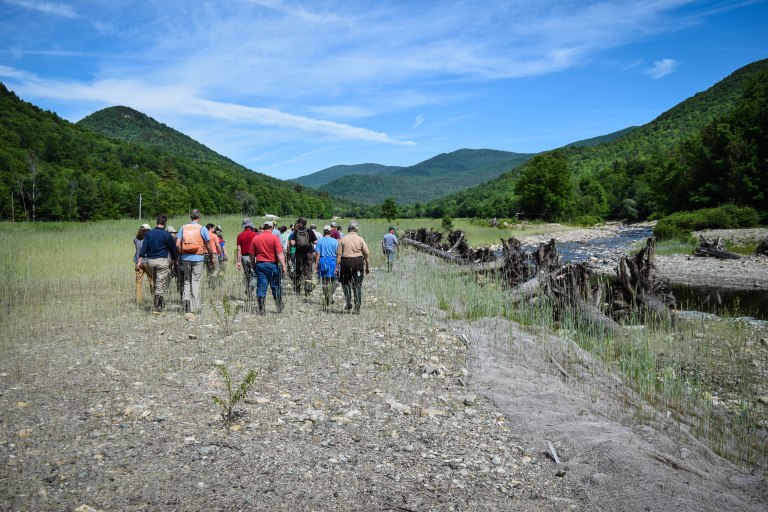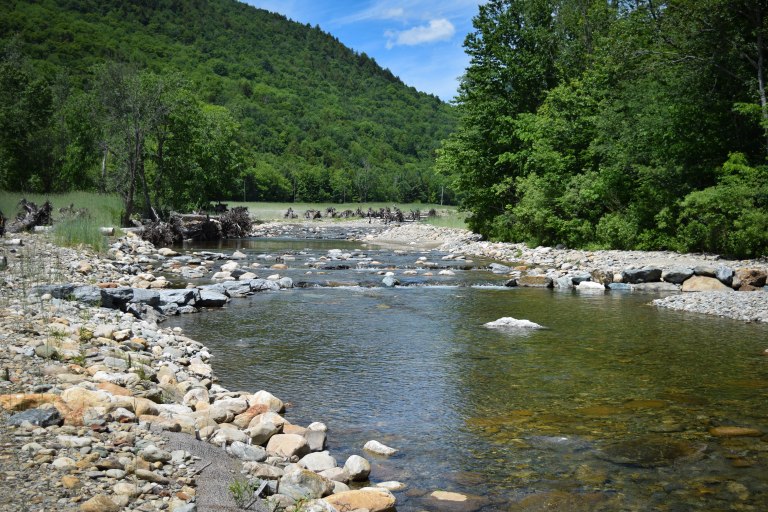As I work on getting new stories together for the site, I’d like to post a few from the old site – for old times sake. Here is the first throwback post. Enjoy (or re-enjoy).

(Graphic:USDA Computational Design Tool for Evaluating the Stability of Large Wood Structures)
It was Tuesday, February 23rd (2016). I was at work and it was freezing outside. I had an email pop in on my phone. “Large Wood Structures for Aquatic Ecosystem Restoration and Management Workshop.” I swear I did a double take.
The class was being organized by the US Forestry Service, Trout Unlimited, and the White River Partnership with the description, The workshop will teach aquatic restoration practitioners the design methodology to engineer log structures that mimic the form and function of naturally occurring log jams. Topics covered will include the role of wood in ecosystems, design of engineered wood structures, and all salient topics of large wood restoration. Here’s the kicker – the class was free. Unfortunately, it was in Vermont, 450 miles away. Oh well, it was probably going to be cool.
When I glanced over at my calendar, I just so happened to see the words “Flat Water Clinic – Twin Ponds” in the adjacent squares. No flippin’ way. I was due to be in the Adirondacks, just down the road from Vermont, for a stillwater fly fishing clinic the day after the workshop ended. Call me Mike Wolfe (American Pickers) because I just became king of the bundle!
The class was three days long. Two days in a classroom setting and one day of site visits. Presenters ranged from Forestry Service folks, to private consultants doing river restoration work, to people from local Trout Unlimited chapters. Everything was discussed from planning and permitting, to management and monitoring.

The location of the class was chosen in order to take an in-depth look at a Large Wood Project that had been successfully implemented. In response to the devastation in New England from Hurricane Irene, the Vermont Highway Department entered a section of the White River and began hauling loads of river gravel away to fill washed out roads. Some sections of river in this area were the straightest I had ever seen and had very homogeneous gradation of gravel. The rivers are full of wild trout, but very few reach larger sizes in the degraded habitat.
Due to the amount of trout I’ve pulled out of wood habitat, I was sold on the benefit of wood in rivers before I arrived. However, the technical back story of wood’s effects on rivers was really driven home. For centuries, we have removed wood from stream channels for transportation of timber during log drives and FEAR of the negative impacts we’ve been told wood has during flood events. This could not be farther from the truth.
A straightened river is an unhealthy river. Flash flooding, poor sediment retention, and shitty fish habitat are a few of the obvious issues with homogeneous channels. Over the years, with increased velocities, stream channels become “incised” and cut themselves off from the flood plain. So what does it mean when a stream doesn’t have access to the floodplain?
Geek Break!
Q = V x A
Ah yes, let’s revisit Algebra 1. You know, it has no relation to everyday life right? Why will you ever need that? In the equation above, Q is volumetric flowrate (cubic feet per second, or (ft^3)/s), V is velocity (feet per second, ft/s), and A is cross-sectional area (square feet, (ft^2)).
So what does that actually mean? When the amount of water coming down stream increases, and the area stays the same (because it can’t spread out over the floodplain) your velocity goes up. More velocity; means more energy, means more scour and erosion.
So how does wood come into play? Wood slows the flow and helps retain and sort various sized stone and sediment particles. Think, have you ever been on a stream where all the stones were roughly the same size? Was it a fairly straight channel? How was the fishing?
Wood can remedy these issues by creating step pool elements which can act as grade control, it can define channel boundaries, it can create and maintain scour in the areas we want it, and it increases floodplain roughness. By increasing floodplain roughness, you force the water to take the path of least resistance and redevelop stream meander in areas where it is currently absent. Wood is deposited on the outside of bends and over time forms log jams which fortify the bank and create habitat.





Wood can, unfortunately accumulate and have adverse impacts on bridges and culverts when it occurs in the wrong setting. Maintenance and monitoring of drainage infrastructure is critical under any circumstance. Large wood is not something to be messed with, but without it, the health of our streams and the quality of fishing is not going to improve. If there is more large wood in streams, more complex structures will accumulate and will be less likely to move and create problems.
When I went to this class, I expected to walk away with tools and design knowledge for implementing wood structures to improve our streams through Trout Unlimited. I got that, but what I also learned was that we need to educate the general public that wood has endless benefits in stream channels. If we can get people to leave the wood that accumulates through natural recruitment in streams, we will see huge, low-cost benefits. So many landowners want to remove wood at the first opportunity because it was common practice for over a century. Even now, I occasionally happen upon un-permitted wood removals and stream channelization to mitigate effects from flooding. One thing is for sure, if wood is removed from streams and channelization and incision continue, flooding will only get worse.
Over the last couple years, we’ve been hearing about the invasive Woolly Adelgid attacking our Hemlock population. I have lost a bit of sleep thinking about the warming that will occur in our headwater streams without shade from these ubiquitous evergreens. One of the speakers totally changed my “doom and gloom” outlook on this impending environmental disaster. “Instead of worrying about the catastrophic loss of hemlocks, think of it as a once in a generation opportunity for wood to be restored through natural recruitment.” Wow. He was absolutely right. If we can educate the masses to NOT remove these dead trees, we could restore the natural wood load so much more than we could by adding structures. Here’s our chance to improve the fishing, people. All we have to do is not screw it up.
There was a little room for fun while I was in Vermont. My wife went with me to the Green Mountain State and we sampled some fantastic local food. I was also able to cross Vermont off the list of places where I had never caught a brook trout!




There’s a paper out of Colorado State by E. Wohl titled “A legacy of absence: Wood removal in US rivers” that summarizes the impacts of systematic removal of woody debris from rivers. If any other readers are interested in learning about the spatial extent of this issue, as well as qualitative impacts, it’s a decent place to start. uses some technical terminology, but nothing too crazy.
LikeLike
Hey Ben, Thanks for pointing that out! If I remember correctly, there was a group of folks from Colorado working on something very similar (could have been the very same paper you mention) at the class in Vermont. I look forward to tracking that paper down and checking it out!
LikeLike